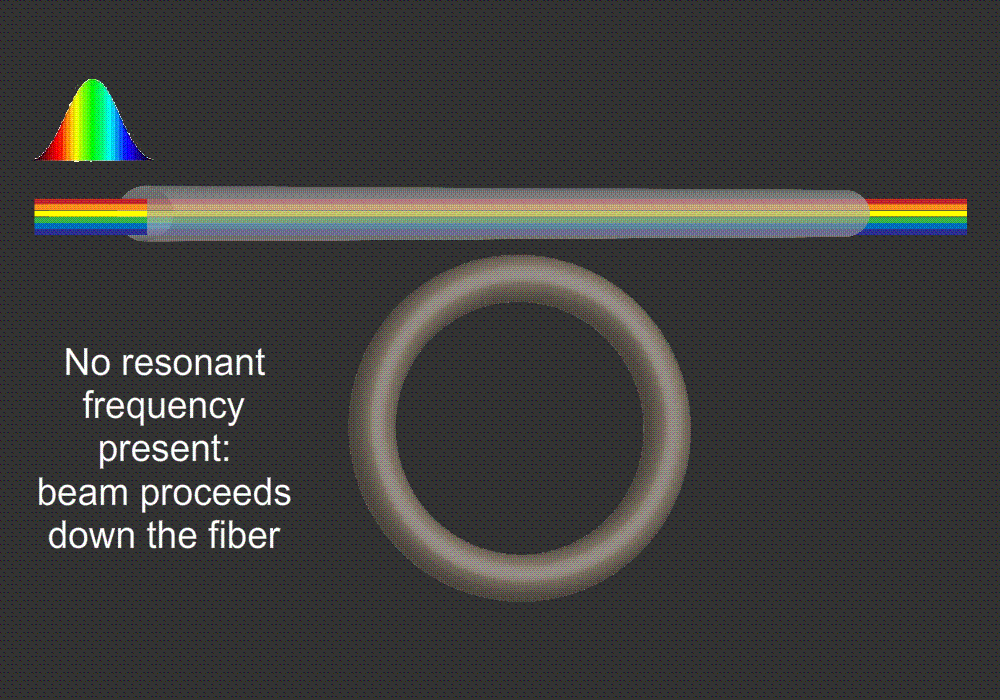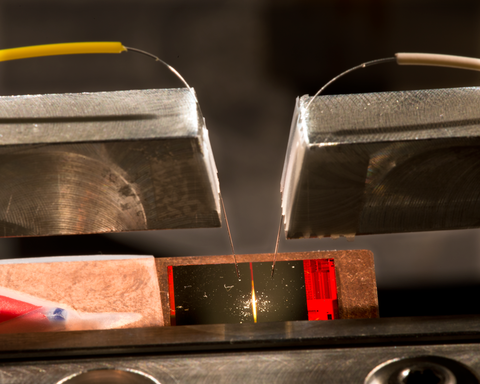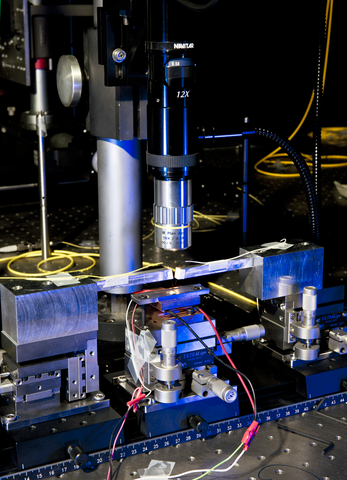
For nearly a century, the instrument of choice for accurate temperature measurements in the range relevant to manufacturing and biomedical applications (–190 °C to 962 °C) has been the standard platinum resistance thermometer (SPRT). Indeed, in the International Temperature Scale of 1990, the International Bureau of Weights and Measures specifies an SPRT as the authoritative device for measurements in that range.
But if a project centered in PML's Thermodynamic Metrology Group is successful, NIST will be able to provide metrology support for a new generation of photonic temperature sensors that offer numerous potential benefits over the venerable SPRT, including lower cost, easier fabrication, far less demanding calibration requirements, rugged construction and tolerance for harsh conditions, small dimensions, resistance to electromagnetic (EM) interference, and remote telemetry. In addition, photonic sensors are readily adaptable to measurements of pressure and even humidity.
Recently the project created a first proof-of-principle prototype of a ring-resonator thermometer (see below) with accuracy equivalent to that of an SPRT. Subsequent research, the group hopes, will result in another order of magnitude improvement, and more importantly will establish optical sensor devices as a viable successor to current standards.
"It's a radical departure from established technology," says Group Leader Greg Strouse. "In the near term, we want to move from voltage-based thermometry to photonics. But the long-term goal is thermodynamic metrology on a chip."
SPRTs work because of the well-characterized relationship between temperature and resistance in platinum conductors. However, the devices are fragile and require electrical connections – properties that make them inappropriate for many key uses. "The oil and gas industries don't want to put a $5,000 SPRT down a well, and they don't want an electrical spark," says project member Zeeshan Ahmed of the Sensor Science Division. "And there are numerous applications in civic infrastructure monitoring, aerospace, telecommunications, and manufacturing for which voltage-based measurement is not really suitable."

The research team, which includes members from the Joint Quantum Institute at the University of Maryland, is proceeding in stages simultaneously on two different kinds of photonic devices. The first employs fiber Bragg gratings (FBGs), tiny structures made axially inside an optical fiber by locally modifying the fiber structure such as to create alternating layers of material with different refractive index. The FBG reflects certain wavelengths while letting all others pass.
As the temperature around a FBG changes, it affects the device's thermo-optic properties, which in turn change the wavelengths it reflects. Similarly, pressure changes cause dimensional changes in the grating, which alter its optical properties. Thus FBGs can be used as sensitive detectors of temperature and pressure.
"The fiber Bragg grating we have is not as accurate as a ring-resonator thermometer," Ahmed says, "but it's lightweight, free of EM interference, essentially passive, and survives in harsh environments where current technology will not survive. If we can devise a common platform for the devices, and develop a calibration standard, all you would need to do is just change the sensor heads to measure pressure and temperature."
"Presumably," Strouse says, "it could be integrated into manufacture of airframe components such as wings so that they can measure key kinds of parameters better. Or it could be employed in infrastructure monitoring of stress on bridges, or temperature changes during the curing of concrete. In addition to better accuracy than we have with current devices, there are other advantages – such as the ability to multiplex signals, which are not as easily done with electrical measurements."
The second sensor type under investigation in the project is based on a ring resonator: a closed loop of total-internal-reflection waveguide, about 10 micrometers in radius, placed adjacent to – but about 100 nanometers to 200 nm away from – the main optical fiber. The resonator will capture or "absorb" wavelengths propagating down the fiber from a laser source if the wavelengths are resonant with the optical properties and dimensions of the loop. Because temperature directly affects those properties and dimensions, the device can serve as a temperature sensor.

"It's first-principles thermometry," Strouse says, "measuring how Brownian motion changes and modulates the wavelengths that pass." The effect has been observed by a few other research teams. But evaluating its suitability as both an industrial and reference thermometer is a long and painstaking process. The PML project will have to determine the optimal configuration and materials, discover how various impurities affect performance, identify sources of quantification errors, and confirm that a given design is stable over time, across temperature ranges, and through numerous repeated cycles, among other tasks.
Were that not enough of a challenge, the PML researchers also want to find a way to integrate the laser source, ring resonator, and data output component onto a single platform that could be made with available nanofabrication technology used to produce microelectromechanical devices. "What we want to end up with," Ahmed says, "is a low-mass thermometer that is very small and very accurate which could easily be deployed in the field." Ideally, the device would also be self-calibrating.
That would solve a number of persistent problems in diverse applications. "This is a sensor technology," Strouse says, "and sensors are typically calibrated against artifacts. We want to move toward intrinsic standards that are blended with the sensors so that the maintenance, calibration, and validation of that sensor is implanted into the system and you don't have to go off-site for anything."
"For example, suppose you need to put an instrument on a satellite. You don't have any way to calibrate it without bringing it down from orbit. The telecommunications industry suffers from same problem. They want to be able to leave temperature-sensitive devices in place for 20 years, and want them to be stable to a drift of 1 mK per year over 10 years. Eventually, engineers designing energy-efficient buildings will want to run fibers throughout the whole building to measure pressure, temperature, and humidity."
Self-calibration, the scientists believe, could be effected by attaching an electrical heater, separated by an insulating layer, to the chip that holds the integrated laser-sensor combination. "The idea," Ahmed says, "is that you apply a current and it generates heat. If you've determined exactly how much heat will diffuse through the layer and into the ring, then if you want to calibrate the sensor, you can just send enough energy in to heat it up to a certain temperature and see if it's still performing to specifications."
"Looking ahead," Strouse says that "eventually, this paradigm shift from resistance- and voltage-based artifacts to photonic-based, self-calibrating artifacts will create a measurement sensor capability that can significantly save money, time, and resources for industry. Additionally, being able to perform chip-scale NIST metrology at the same level as that currently performed on a macro scale potentially fuels new micro- and nanoscale technologies."

